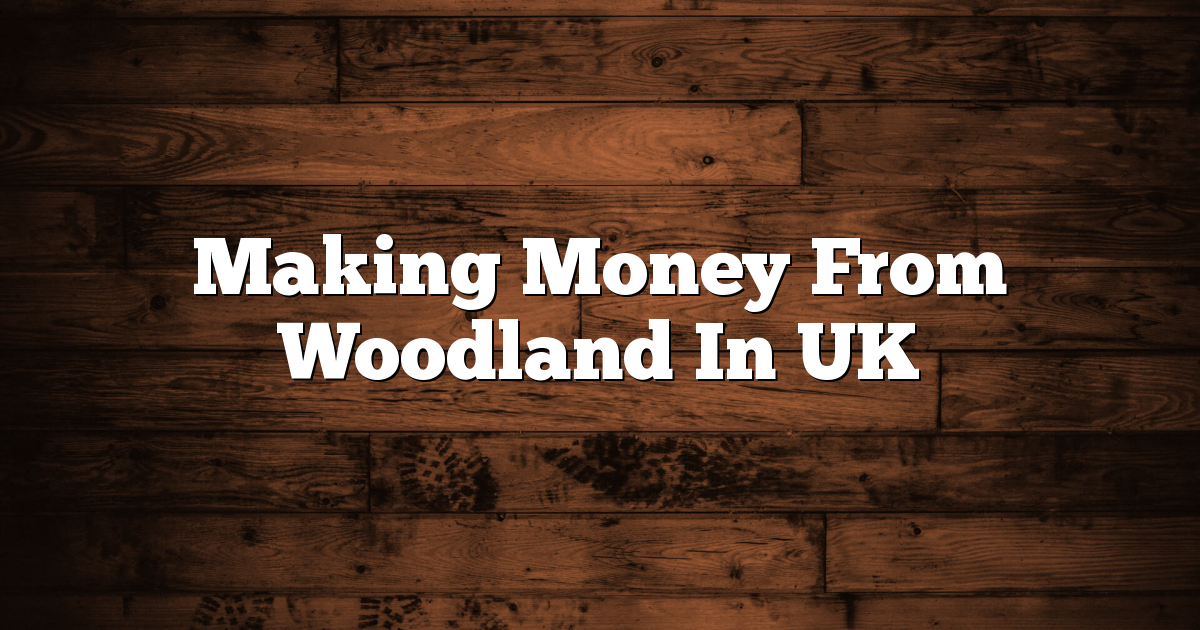Making Money From Woodland In UK

Hey there, folks! Let's talk about a topic that might just pique your interest and get those entrepreneurial gears turning. We're diving into the world of making money from woodland in the UK. Now, I know what you're thinking – making money from trees? How on earth does that work? Well, my friends, prepare to be amazed because there's a whole lot more to woodlands than meets the eye. From sustainable timber production to eco-tourism and everything in between, the opportunities are as vast as the forest itself. So, grab your hiking boots and let's explore the exciting ways you can turn those trees into some serious green.
Woodland Ownership in the UK
Woodland ownership in the UK is a fascinating and complex topic that delves into the relationship between people and nature. When we talk about woodland ownership, we're not just talking about who physically owns the land, but also the responsibilities and rights that come with it. It's like being the captain of a ship, but instead of sailing the high seas, you're navigating through a lush forest.
In the UK, woodland ownership is divided between private individuals, corporations, and the government. Private individuals can own woodlands for various reasons, whether it's for recreational purposes, conservation efforts, or even as an investment. These woodland owners have the power to shape the future of the forest, deciding what activities are allowed and how the land is managed. It's like being the guardian of a secret garden, with the power to nurture and protect its beauty.
Corporations also play a significant role in woodland ownership. They may own woodlands for commercial purposes, such as timber production or recreational activities like camping and hiking. These corporations have the resources and expertise to manage large areas of woodland, ensuring its sustainability and profitability. It's like being the CEO of a green empire, where the trees are your loyal employees, working tirelessly to provide for you.
Lastly, the government also owns a significant portion of woodlands in the UK. These woodlands are often managed by organizations like the Forestry Commission, who are responsible for preserving and enhancing the natural environment. Government-owned woodlands are like national treasures, protected for the enjoyment and benefit of all. It's like being a steward of the land, entrusted with the task of preserving its beauty for future generations.
In conclusion, woodland ownership in the UK is a multifaceted topic that goes beyond mere property rights. It involves the delicate balance between human needs and the preservation of nature. Whether it's private individuals, corporations, or the government, each owner has a unique role to play in shaping the future of our woodlands. So next time you take a stroll through a beautiful forest, remember that there's a whole world of ownership and responsibility behind those towering trees.
Woodland Management for Profit
Alright, let's talk about woodland management for profit! Now, when it comes to making some green from your trees, there are a few things you need to keep in mind. First off, you gotta have a solid plan in place. You can't just go chopping down trees left and right without thinking about the long-term consequences. So, take a step back and think about what you want to achieve with your woodland.
Once you've got your plan sorted, it's time to get down to business. One of the key things to consider is the type of trees you have in your woodland. Different trees have different values, you know? Some might be great for timber, while others are more suited for firewood or even specialty products like furniture. So, it's important to know what you've got and how you can make the most of it.
Now, let's talk about harvesting. It's not just about cutting down trees and calling it a day. You gotta be strategic about it. Think about the age and size of the trees, as well as their overall health. You don't want to be cutting down young trees that still have a lot of growing to do, nor do you want to be chopping down sickly ones. It's all about finding that sweet spot where you can maximize your profits without harming the future of your woodland.
So, there you have it! Woodland management for profit in a nutshell. Remember, it's all about having a solid plan, knowing your trees, and being strategic with your harvesting. With a little bit of know-how and some hard work, you'll be on your way to making some serious cash from your woodland. Good luck, my friend!
Types of Woodland Businesses in the UK
Alright, let's dive into the different types of woodland businesses you can find in the UK. Now, when we talk about woodland businesses, we're not just talking about your typical lumberjack chopping down trees. Oh no, my friend, there's a whole world of opportunities out there in the woods.
First up, we have the timber industry. This is where the big boys come in and harvest trees for their wood. They use specialized machinery to fell the trees, process the timber, and then sell it to various industries. You've got everything from construction companies needing timber for building projects to furniture manufacturers looking for that perfect piece of wood to craft their creations. It's a tough and physically demanding job, but it's also a vital part of the economy.
Next, we have the eco-tourism sector. Now, this is where things get interesting. Picture this: you're walking through a beautiful woodland, birds chirping, sunlight streaming through the trees, and you stumble upon a cozy little cabin nestled among the foliage. That, my friend, is eco-tourism at its finest. These woodland businesses offer visitors a chance to escape the hustle and bustle of city life and immerse themselves in nature. They provide accommodation, guided tours, and even activities like hiking, birdwatching, and foraging. It's all about reconnecting with the great outdoors and experiencing the beauty of the woodlands.
Last but not least, we have the woodland crafts industry. This is where creativity meets nature. Think of it as a haven for artisans and craftsmen who love working with wood. From woodcarving to basket weaving, these businesses specialize in creating unique and handcrafted products using materials sourced from the woodlands. They take pride in their craftsmanship and often use traditional techniques passed down through generations. Whether it's a beautifully carved wooden sculpture or a handwoven basket, these businesses bring a touch of nature into our everyday lives.
So there you have it, my friend. The world of woodland businesses in the UK is diverse and full of opportunities. From the timber industry to eco-tourism and woodland crafts, there's something for everyone. Whether you're a nature lover, an entrepreneur, or just someone looking for a change of scenery, the woodlands have got you covered. So go ahead, explore the possibilities, and embrace the beauty of the great outdoors.
Investing in Woodland for Financial Gain
Investing in Woodland for Financial Gain: A Green and Lucrative Venture
Alright, so you're thinking about investing in woodland, huh? Well, let me tell you, my friend, it's not just a walk in the park. Investing in woodland can be a green and lucrative venture if you play your cards right. But before you dive headfirst into the forest, let's break it down and explore the ins and outs of this natural investment opportunity.
First things first, why invest in woodland? Well, picture this: a lush green oasis, teeming with life, and brimming with potential. Woodland is not just a pretty sight, it's a valuable asset. With the increasing demand for timber, the price of wood is on the rise. And guess what? You can be a part of this booming industry. By investing in woodland, you're not only securing a piece of nature, but you're also tapping into a sustainable source of income.
Now, let's talk about the nitty-gritty of investing in woodland. It's not as simple as buying a plot of land and waiting for the trees to grow. No, my friend, it requires careful planning and management. You need to consider factors like the type of trees you want to grow, the soil quality, and the climate of the area. Different trees have different growth rates and market values, so you need to do your research and choose wisely.
Once you've got your woodland up and running, it's time to reap the rewards. Timber harvesting can be a profitable venture, but it requires patience. Trees take time to grow, and you need to strike a balance between harvesting and replanting. It's like a delicate dance, my friend. But if you play your cards right, you can enjoy a steady stream of income from selling timber.
So, investing in woodland for financial gain is not just about making money, it's about nurturing nature and reaping the rewards. It's a green and lucrative venture that requires careful planning and management. But hey, if you're up for the challenge, the woodland can be your ticket to a sustainable and profitable future. So go ahead, my friend, and let your investment bloom like the trees in the forest.
Woodland as a Source of Renewable Energy
Woodland, my friend, is not just a picturesque backdrop for fairy tales and nature walks. It holds within its depths a hidden treasure, a source of renewable energy that can power our modern world. Let me take you on a journey through the wonders of woodland as a renewable energy source, and you'll see why it's more than just a bunch of trees.
First and foremost, we have the mighty trees themselves. These towering giants are not only a sight to behold, but they also hold the key to unlocking renewable energy. Through a process called biomass energy, we can harness the power of wood and convert it into heat and electricity. Imagine, my friend, the warmth of a cozy fire or the glow of a light bulb, all powered by the very essence of nature itself.
But it doesn't stop there, oh no! Woodland is a treasure trove of other renewable energy sources as well. Have you ever heard of wood pellets? These little nuggets of energy are made from compressed sawdust and wood shavings, and they can be used as a clean and efficient fuel source. They can be burned in specialized stoves and boilers, providing heat for homes and even powering entire communities. It's like having a mini forest in your own backyard, fueling your every need.
And let's not forget about the magical process of photosynthesis. This incredible phenomenon, carried out by the leaves of trees, converts sunlight into energy. By harnessing this power, we can create solar panels made from wood, known as “solar wood.” These panels not only generate electricity but also have a natural aesthetic appeal, blending seamlessly into the surrounding woodland. It's like nature's own way of saying, “I've got your back, humans!”
So you see, my friend, woodland is not just a pretty face. It's a renewable energy powerhouse, providing us with heat, electricity, and even solar power. With the right technology and a little bit of imagination, we can tap into this abundant resource and create a sustainable future for ourselves and generations to come. So let's embrace the wonders of woodland and let it fuel our journey towards a greener and brighter tomorrow.
Woodland as a Source of Timber and Wood Products
So, let's talk about woodlands and how they serve as a valuable source of timber and wood products. Now, when we think of woodlands, we often picture these lush, green areas filled with towering trees and a sense of tranquility. But did you know that woodlands play a crucial role in providing us with the timber and wood products that we use in our everyday lives?
Firstly, let's delve into the process of obtaining timber from woodlands. It all starts with careful planning and sustainable management. Foresters assess the woodland, identifying which trees are ready for harvesting while ensuring the overall health and biodiversity of the forest is maintained. Once the trees are selected, skilled loggers carefully fell them, ensuring minimal damage to the surrounding environment. The felled trees are then transported to sawmills, where they are processed into timber of various sizes and shapes.
Now, timber is not the only product we get from woodlands. These diverse ecosystems also provide us with a wide range of wood products. From furniture and flooring to paper and packaging materials, wood is an incredibly versatile material. Craftsmen and artisans transform the timber into beautiful and functional objects that enhance our daily lives. And let's not forget about the countless other wood products like doors, windows, and even musical instruments that are derived from woodlands.
But it's not just about the end products. Woodlands also offer numerous environmental benefits. They act as carbon sinks, absorbing and storing carbon dioxide, a greenhouse gas that contributes to climate change. Woodlands also provide habitats for countless species, supporting biodiversity and preserving our natural heritage. Additionally, they help regulate water cycles, prevent soil erosion, and improve air quality. So, it's clear that woodlands are not just a source of timber and wood products, but they are also vital for the health of our planet.
In conclusion, woodlands are more than just picturesque landscapes. They are a valuable source of timber and wood products that we rely on in our daily lives. From the careful planning and sustainable management of forests to the skilled craftsmanship that transforms timber into various products, woodlands play a crucial role in providing us with the materials we need. Moreover, they offer numerous environmental benefits, making them essential for the well-being of our planet. So, let's appreciate and protect these precious woodlands for the many gifts they provide us.
Woodland for Recreation and Tourism
So, let's talk about woodlands for recreation and tourism, my friend. Picture this: you're out in the great outdoors, surrounded by towering trees, the scent of pine filling the air. The sunlight filters through the leaves, creating a mesmerizing dance of shadows on the forest floor. It's a place where you can escape the hustle and bustle of everyday life, and just immerse yourself in nature's embrace.
Woodlands have become increasingly popular destinations for people seeking recreational activities and a break from the monotony of city life. Whether it's hiking, camping, birdwatching, or simply taking a leisurely stroll, these natural havens offer a wide range of opportunities for outdoor enthusiasts. Imagine yourself hiking along a well-marked trail, the crunch of leaves beneath your feet, as you discover hidden waterfalls and breathtaking vistas. It's a chance to reconnect with nature, to breathe in the fresh air, and to rejuvenate your soul.
But it's not just about the physical activities, my friend. Woodlands also provide a unique setting for tourism. Imagine staying in a cozy cabin nestled in the heart of the forest, waking up to the sound of birds chirping and the gentle rustling of leaves. You can spend your days exploring the surrounding area, visiting local attractions, and immersing yourself in the rich cultural heritage of the region. From quaint villages to historic landmarks, there's so much to discover and experience.
So, whether you're an adventure seeker or a culture enthusiast, woodlands offer a little something for everyone. They provide a sanctuary where you can escape the chaos of everyday life and reconnect with the beauty of the natural world. So, why not pack your bags, my friend, and embark on a journey to a woodland paradise? The wonders of nature await you, ready to be explored and cherished.
Woodland for Wildlife Conservation and Biodiversity
Alright, let's talk about woodland for wildlife conservation and biodiversity. Now, picture this: a lush, vibrant forest teeming with life. Birds chirping, squirrels scampering, and a gentle breeze rustling through the leaves. This is the kind of place that not only takes your breath away but also plays a crucial role in preserving our planet's biodiversity.
Woodlands are like nature's superheroes, providing a safe haven for countless species of plants and animals. They act as a natural habitat, offering food, shelter, and protection to a diverse range of wildlife. From majestic deer to elusive foxes, from delicate wildflowers to towering oak trees, woodlands are a treasure trove of biodiversity.
But it's not just about the animals and plants that call woodlands home. These ecosystems also play a vital role in maintaining a healthy environment for us humans. Woodlands act as carbon sinks, absorbing and storing carbon dioxide, a greenhouse gas that contributes to climate change. They also help regulate water cycles, preventing soil erosion and flooding. So, by conserving and protecting woodlands, we're not only safeguarding wildlife but also ensuring a sustainable future for ourselves.
In order to preserve woodlands for wildlife conservation and biodiversity, it's important to implement effective management strategies. This includes maintaining a balance between natural processes and human intervention. For example, controlled burning can help rejuvenate woodlands by clearing out dead vegetation and promoting new growth. Additionally, creating wildlife corridors and protected areas within woodlands can help connect fragmented habitats and allow for the movement of species.
So, whether you're a nature enthusiast or simply someone who appreciates the beauty of the great outdoors, supporting woodland conservation efforts is crucial. By doing so, we can ensure that future generations get to experience the wonder and diversity of these incredible ecosystems. Let's work together to protect our woodlands and the wildlife that depend on them.
Woodland as a Carbon Offset Investment
Woodland as a Carbon Offset Investment: A Breath of Fresh Air for Your Portfolio
Alright, so you're looking to invest your hard-earned cash, huh? Well, let me tell you about a little gem that's been flying under the radar: woodland as a carbon offset investment. Now, I know what you're thinking, “Trees? Really?” But trust me, my friend, this is not your average investment opportunity.
Picture this: a lush forest, teeming with life, stretching as far as the eye can see. The air is crisp and clean, and the scent of pine fills your nostrils. This is the kind of place that makes you feel alive, connected to nature in a way that's hard to put into words. And guess what? By investing in woodland, you can not only protect these precious ecosystems but also make a tidy profit.
Here's the deal: trees are like the superheroes of the natural world. They absorb carbon dioxide, a pesky greenhouse gas that's wreaking havoc on our planet, and release oxygen, the stuff we need to breathe. By investing in woodland, you're essentially buying into a carbon offset project. As the trees grow, they suck up more and more carbon dioxide, effectively reducing the amount of greenhouse gases in the atmosphere. And guess what? Big corporations are willing to pay top dollar for these carbon offsets to meet their sustainability goals. Cha-ching!
But hold on, I hear you asking, “How do I get in on this action?” Well, my friend, there are a few ways you can invest in woodland. You can buy shares in a timberland investment management organization (TIMO), which manages forests and sells carbon offsets on your behalf. Alternatively, you can invest directly in a woodland project, either by purchasing land or partnering with an existing project. Just make sure you do your research and choose a reputable organization that aligns with your values.
So, there you have it, my friend. Woodland as a carbon offset investment is not only a smart financial move but also a way to make a positive impact on our planet. It's like hitting two birds with one stone, or should I say, planting two trees with one seed? So go ahead, take a deep breath, and dive into the world of woodland investments. Your portfolio—and the planet—will thank you.
Woodland Grants and Funding Opportunities in the UK
Alright, mate! Let's talk about woodland grants and funding opportunities in the UK. Now, I know what you're thinking – grants and funding, that sounds boring as hell. But trust me, this is some important stuff, especially if you're into nature and conservation.
So, here's the deal. In the UK, there are various grants and funding opportunities available for individuals and organizations who want to get involved in woodland projects. These grants are like a pot of gold for those who are passionate about preserving our beautiful woodlands and making a positive impact on the environment.
Now, you might be wondering, what kind of projects are we talking about here? Well, it could be anything from planting new trees and managing existing woodlands to creating wildlife habitats and improving public access. The possibilities are endless, really. And the best part is, these grants can help cover the costs of things like buying land, equipment, and even paying for the manpower needed to get the job done.
But hold on, mate, it's not just about the money. These grants also come with a bunch of other benefits. For starters, they can provide you with expert advice and guidance on how to make the most of your woodland project. They can hook you up with professionals who know their stuff and can help you navigate the ins and outs of woodland management. Plus, they often offer training and networking opportunities, so you can learn from others who are just as passionate about woodlands as you are.
So, if you're itching to get involved in woodland conservation and make a difference in your community, don't let the idea of grants and funding scare you off. There are plenty of opportunities out there, waiting for folks like you to grab them by the horns. So go on, mate, get out there and show Mother Nature some love!
Another post you might find useful is, Making Money From Youtube Videos.
I've also written about Making Money From Watching Videos, so feel free to check that out, or bookmark it for later!






